必修一Unit3 听说课教学设计
高中英语人教版必修第一册Unit 3 Listening and Talking 教学设计-
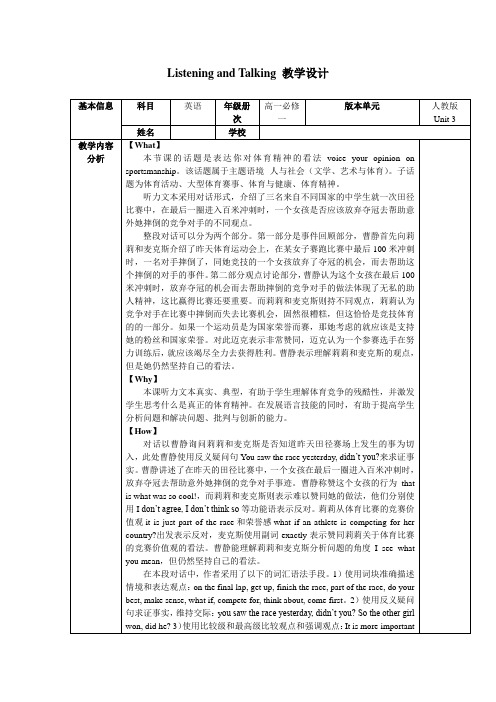
Listening and Talking 教学设计基本信息科目英语年级册次高一必修一版本单元人教版Unit 3姓名学校教学内容分析【What】本节课的话题是表达你对体育精神的看法voice your opinion on sportsmanship。
该话题属于主题语境--人与社会(文学、艺术与体育)。
子话题为体育活动、大型体育赛事、体育与健康、体育精神。
听力文本采用对话形式,介绍了三名来自不同国家的中学生就一次田径比赛中,在最后一圈进入百米冲刺时,一个女孩是否应该放弃夺冠去帮助意外她摔倒的竞争对手的不同观点。
整段对话可以分为两个部分。
第一部分是事件回顾部分,曹静首先向莉莉和麦克斯介绍了昨天体育运动会上,在某女子赛跑比赛中最后100米冲刺时,一名对手摔倒了,同她竞技的一个女孩放弃了夺冠的机会,而去帮助这个摔倒的对手的事件。
第二部分观点讨论部分,曹静认为这个女孩在最后100米冲刺时,放弃夺冠的机会而去帮助摔倒的竞争对手的做法体现了无私的助人精神,这比赢得比赛还要重要。
而莉莉和麦克斯则持不同观点,莉莉认为竞争对手在比赛中摔倒而失去比赛机会,固然很糟糕,但这恰恰是竞技体育的的一部分。
如果一个运动员是为国家荣誉而赛,那她考虑的就应该是支持她的粉丝和国家荣誉。
对此迈克表示非常赞同,迈克认为一个参赛选手在努力训练后,就应该竭尽全力去获得胜利。
曹静表示理解莉莉和麦克斯的观点,但是她仍然坚持自己的看法。
【Why】本课听力文本真实、典型,有助于学生理解体育竞争的残酷性,并激发学生思考什么是真正的体育精神。
在发展语言技能的同时,有助于提高学生分析问题和解决问题、批判与创新的能力。
【How】对话以曹静询问莉莉和麦克斯是否知道昨天田径赛场上发生的事为切入,此处曹静使用反义疑问句You saw the race yesterday, d idn’t you?来求证事实。
曹静讲述了在昨天的田径比赛中,一个女孩在最后一圈进入百米冲刺时,放弃夺冠去帮助意外她摔倒的竞争对手事迹。
Unit3+听说课教案 高中英语人教版(2019)必修第一册 (1)
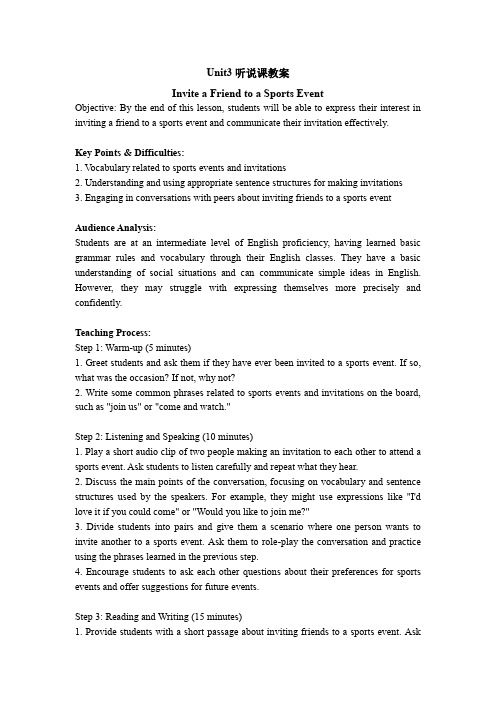
Unit3听说课教案Invite a Friend to a Sports EventObjective: By the end of this lesson, students will be able to express their interest in inviting a friend to a sports event and communicate their invitation effectively.Key Points & Difficulties:1. V ocabulary related to sports events and invitations2. Understanding and using appropriate sentence structures for making invitations3. Engaging in conversations with peers about inviting friends to a sports eventAudience Analysis:Students are at an intermediate level of English proficiency, having learned basic grammar rules and vocabulary through their English classes. They have a basic understanding of social situations and can communicate simple ideas in English. However, they may struggle with expressing themselves more precisely and confidently.Teaching Process:Step 1: Warm-up (5 minutes)1. Greet students and ask them if they have ever been invited to a sports event. If so, what was the occasion? If not, why not?2. Write some common phrases related to sports events and invitations on the board, such as "join us" or "come and watch."Step 2: Listening and Speaking (10 minutes)1. Play a short audio clip of two people making an invitation to each other to attend a sports event. Ask students to listen carefully and repeat what they hear.2. Discuss the main points of the conversation, focusing on vocabulary and sentence structures used by the speakers. For example, they might use expressions like "I'd love it if you could come" or "Would you like to join me?"3. Divide students into pairs and give them a scenario where one person wants to invite another to a sports event. Ask them to role-play the conversation and practice using the phrases learned in the previous step.4. Encourage students to ask each other questions about their preferences for sports events and offer suggestions for future events.Step 3: Reading and Writing (15 minutes)1. Provide students with a short passage about inviting friends to a sports event. Askthem to read the passage silently and underline any new vocabulary or phrases they encounter.2. Discuss the passage with students, focusing on the vocabulary and sentence structures used. Encourage them to use these new words and structures in their own conversations about inviting friends to sports events.3. Ask students to write a short message inviting a friend to a sports event of their choice. Encourage them to use the phrases learned in the listening and speaking activities and provide feedback on their writing.Step 4: Wrap-up (5 minutes)1. Review the key points covered in the lesson, including vocabulary related to sports events and invitations, sentence structures for making invitations, and ways to engage in conversations with peers about inviting friends to a sports event.2. Ask students if they have any questions or concerns about inviting friends to sports events in English. Encourage them to continue practicing their language skills outside of class by attending sporting events with friends or family members who speak English.。
Unit3+听说课教案 高中英语人教版(2019)必修第一册
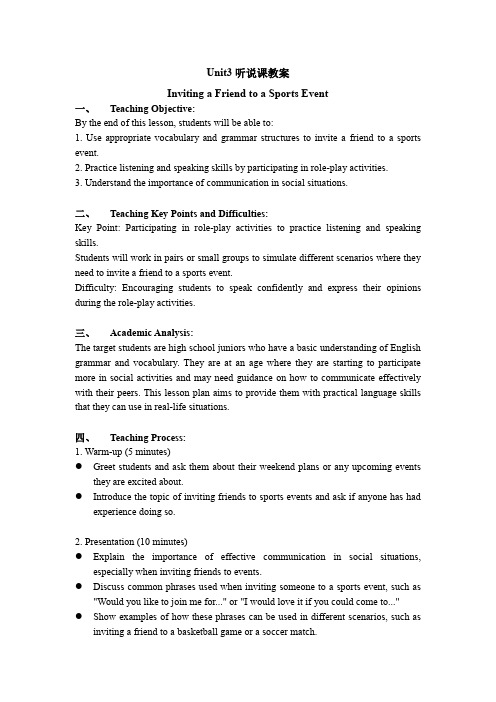
Unit3听说课教案Inviting a Friend to a Sports Event一、Teaching Objective:By the end of this lesson, students will be able to:1. Use appropriate vocabulary and grammar structures to invite a friend to a sports event.2. Practice listening and speaking skills by participating in role-play activities.3. Understand the importance of communication in social situations.二、Teaching Key Points and Difficulties:Key Point: Participating in role-play activities to practice listening and speaking skills.Students will work in pairs or small groups to simulate different scenarios where they need to invite a friend to a sports event.Difficulty: Encouraging students to speak confidently and express their opinions during the role-play activities.三、Academic Analysis:The target students are high school juniors who have a basic understanding of English grammar and vocabulary. They are at an age where they are starting to participate more in social activities and may need guidance on how to communicate effectively with their peers. This lesson plan aims to provide them with practical language skills that they can use in real-life situations.四、Teaching Process:1. Warm-up (5 minutes)●Greet students and ask them about their weekend plans or any upcoming eventsthey are excited about.●Introduce the topic of inviting friends to sports events and ask if anyone has hadexperience doing so.2. Presentation (10 minutes)●Explain the importance of effective communication in social situations,especially when inviting friends to events.●Discuss common phrases used when inviting someone to a sports event, such as"Would you like to join me for..." or "I would love it if you could come to..."●Show examples of how these phrases can be used in different scenarios, such asinviting a friend to a basketball game or a soccer match.3. Practice (15 minutes)●Divide students into pairs or small groups and give each group a set of scenariocards with different ways of inviting a friend to a sports event.●Ask students to role-play the scenarios using the phrases they learned in thepresentation, making sure to encourage them to speak confidently and express their opinions.●After each pair or group has finished their role-play, ask for feedback from therest of the class on their performance and offer suggestions for improvement.4. Production (10 minutes)●Have one student from each pair or group present their role-play to the class,focusing on their use of language and expressions learned in the lesson.●Assess their performance based on factors such as pronunciation, grammaraccuracy, and confidence in speaking.5. Consolidation (5 minutes)●Review the key points and difficulties of the lesson, encouraging students toreflect on what they learned and how they can apply it in their daily lives.●Encourage students to continue practicing their English skills outside of class byinviting friends to other events, such as movie nights or dinner dates.。
Unit3+听力课教案 高中英语人教版(2019)必修第一册 (1)

Unit3听力课教案Invite a Friend to a Sports EventObjective: By the end of the lesson, students will be able to express their intention to invite a friend to a sports event in English and understand the main points of the conversation.Key Points: V ocabulary related to sports events, invitation, and expressing willingness to attend.Teaching Aids: PowerPoint presentation with images related to sports events and vocabulary words, audio recording of a conversation between two friends inviting each other to a sports event, and worksheets for practice.Lesson Procedure:1. Warm-up (5 minutes)- Greet the students and ask them about their favorite sports events.- Introduce the topic of the lesson by asking if anyone has ever invited a friend to a sports event.- Write the vocabulary words "sports event," "invitation," and "willingness" on the board.2. Listening Practice (10 minutes)- Play an audio recording of two friends discussing inviting each other to a sports event.-Ask the students to listen carefully and take notes on the main points of the conversation.- Distribute worksheets with questions based on the listening practice.3. Production (15 minutes)- Divide the students into pairs and give them a scenario where one student wants to invite the other to a sports event.- Ask them to use the vocabulary words from the warm-up and discuss their ideas for inviting their friends in English.- Encourage them to ask questions and provide feedback on their pronunciation and grammar.- Afterward, ask for volunteers to share their conversation with the class.4. Consolidation (5 minutes)-Review the key points of the listening practice and ask the students if theyunderstood everything correctly.- Answer any remaining questions from the worksheets.- Recap the vocabulary words and phrases learned in this lesson.5. Homework (5 minutes)- Ask the students to write a short essay about inviting a friend to a sports event using the vocabulary and phrases learned in this lesson.- Encourage them to include personal experiences or anecdotes related to sports events they have attended or planned to attend.Assessment: The effectiveness of the lesson will be assessed through the students' participation in the listening practice, production, and homework assignments. Additionally, their ability to answer questions related to the key points of the lesson will be evaluated during class discussions.。
人教必修1英语Unit3 听说课 公开课课件教学设计

Unit 3 听说课公开课教学设计Topic: Unit 3 Travel JournalLesson Plan for 3 and 4 period (Listening, Speaking and Writing)听力、口语、写作课教学设计授课老师:田家炳中学张远航教学年级:高中一年级授课内容:Unit 3 Travel Journal 第三、四课时听力、口语、写作课设计授课时间:45分钟(备注:录像课为第四课时)(一)学生分析学生年龄大多在16-17岁,已意识到英语的重要性,希望学好英语,但对英语的兴趣并不是很浓厚。
中考全班英语平均分约60分,他们通过初中三年的学习,相当部分同学已具有一定的听说读写能力、自主学习能力和分析能力,但一部分学生存在回答问题时声音太小,不敢大胆表达自己观点,怕出现错误,根据高中教学的要求,仍需要进一步的提高,特别是听力、口语和写作能力。
本单元的中心话题是“旅游”,可以说这是一个世界性的时尚话题,随着经济发展、社会进步、人们生活水平的提高,旅游作为现代人的一种生活方式,越来越被更多的人们所接受与喜爱。
学生对旅行比较感兴趣,旅行经验不是很丰富。
通过对本单元第一、二部分的学习,对湄公河背景知识有一定的了解,他们渴望了解河流流经国家的相关情况。
(二)教材分析1.本课所处本单元的位置这是本单元的第三、四课时,是一节听力、口语、写作课。
2.课前的学习内容与本节内容的内在联系本单元讲述了一段沿湄公河而下的自行车旅行,主人公“王坤”以旅行日记的形式详细的记录了这一过程。
学习了单元的第一、二课时,同学们已经了解了湄公河的背景知识和旅行路线,为这节课做好了铺垫。
3.对教材的处理教材要求学生具备一定听说写能力,以路线为单元主线设计听说写课时。
主人公“王坤”等离开云南后进入老挝,遇到一位女孩,向她了解了湄公河沿岸的美丽景色和住宿的地方。
当晚他们住在一个非常安静的村庄。
第三、四课时旨在培养学生听力能力,把听力作为输入,以说和写作为输出,并培训学生写旅行日记的能力。
高中英语人教版必修第一册Unit 3 Listening and Speaking 教学设计-
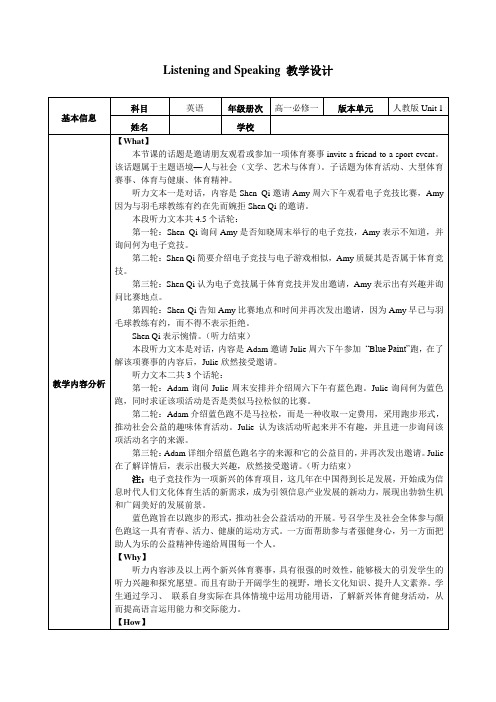
Listening and Speaking 教学设计基本信息科目英语年级册次高一必修一版本单元人教版Unit 1姓名学校教学内容分析【What】本节课的话题是邀请朋友观看或参加一项体育赛事invite a friend to a sport event。
该话题属于主题语境—人与社会(文学、艺术与体育)。
子话题为体育活动、大型体育赛事、体育与健康、体育精神。
听力文本一是对话,内容是Shen Qi邀请Amy周六下午观看电子竞技比赛,Amy 因为与羽毛球教练有约在先而婉拒Shen Qi的邀请。
本段听力文本共4.5个话轮:第一轮:Shen Qi询问Amy是否知晓周末举行的电子竞技,Amy表示不知道,并询问何为电子竞技。
第二轮:Shen Qi简要介绍电子竞技与电子游戏相似,Amy质疑其是否属于体育竞技。
第三轮:Shen Qi认为电子竞技属于体育竞技并发出邀请,Amy表示出有兴趣并询问比赛地点。
第四轮:Shen Qi告知Amy比赛地点和时间并再次发出邀请,因为Amy早已与羽毛球教练有约,而不得不表示拒绝。
Shen Qi表示惋惜。
(听力结束)本段听力文本是对话,内容是Adam邀请Julie周六下午参加“B lue Paint”跑,在了解该项赛事的内容后,Julie欣然接受邀请。
听力文本二共3个话轮:第一轮:Adam询问Julie周末安排并介绍周六下午有蓝色跑。
Julie询问何为蓝色跑,同时求证该项活动是否是类似马拉松似的比赛。
第二轮:Adam介绍蓝色跑不是马拉松,而是一种收取一定费用,采用跑步形式,推动社会公益的趣味体育活动。
Julie认为该活动听起来并不有趣,并且进一步询问该项活动名字的来源。
第三轮:Adam详细介绍蓝色跑名字的来源和它的公益目的,并再次发出邀请。
Julie 在了解详情后,表示出极大兴趣,欣然接受邀请。
(听力结束)注:电子竞技作为一项新兴的体育项目,这几年在中国得到长足发展,开始成为信息时代人们文化体育生活的新需求,成为引领信息产业发展的新动力,展现出勃勃生机和广阔美好的发展前景。
Unit3SportsandFitnessListeningandTalking教学设计-高一上学期
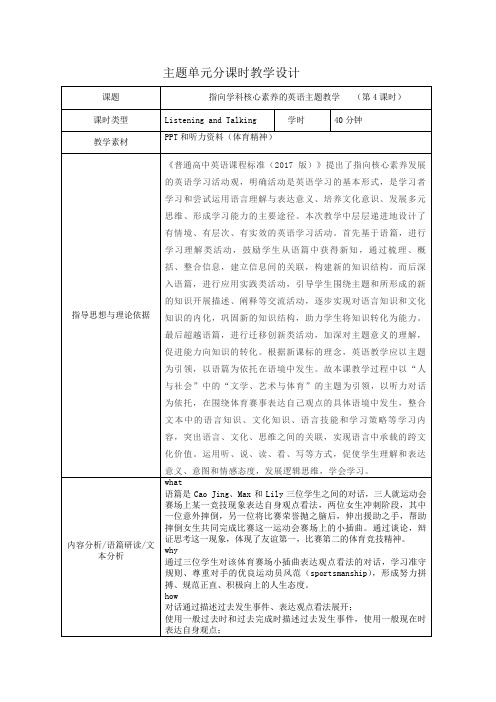
主题单元分课时教学设计
强调学生需要听取三
位同学的不同观点,
并完成活动Ⅰ的题
目:
本阶段的学习活动旨在帮助学生听取文本中任务观点,并作出判断;为后面关于体育精神的探讨作出铺垫;
指导学生再次听取
听力材料,并识别
文本中使用的关于
“赞同”或“不赞
同”的表达
设计意图:本阶段的学习活动旨在引导学进一步听取听力材料,在更了解内容的基础上听懂关
教师提问问题:
“Who do you
agree with?”展示
包括 agreement or
disagreement,
reason, example,
and conclusion的
信息内容。
For
example:An
athlete should do
his/her best to
win.
I agree with
you. …I see
what you mean,
but…并指导学生完
成任务Ⅲ:Whether
a soccer player
should pretend to
fall down even if
it helps his/her
team or not?
Choose one of the three situations below and prepare。
人教课标版高中英语必修一Unit3ListeningandSpeaking教案-新版

人教课标版高中英语必修一Unit3ListeningandSpeaking教案-新版Unit3 Listening and Speaking 教学设计Unit 3 Travel journal (BookⅠ)第四课时(Listening & Speaking)1. Teaching Analysis 教情分析1.1 Teaching objectives-教学目标1.1.1 Language target语言目标1.1.1.1 Key words & expressions重点词汇和短语1.1.1.1.1 For applying: temple, cave, predict, appear, disappear, transport, waterfall, rock, plain, the national flag, speak to, travel along, use for, no wonder, as useful as, watch out for, plenty of, in a low voice, all the way, on one’s way, make a difference, take care, have fun, say hello to1.1.1.1.2 For comprehending: border, village, candle, truck, duck, chicken, modern, make an early start, lifestyle, protected, leave over1.1.1.1.3 For recognizing: tuk-tuk, Laos, Vientiane, Laotian1.1.1.2 Sentence structures:①A girl from Laos told Wang Kun about how important and beautiful the Mekong is. P23②Laotian people use the driver for washing, fishing and transporting goods and people around the country. P23③ They call the Mekong “ the sea of Laos”, but in Tibet, China people call it “ the water of the rocks”.. P231.1.2 Ability goals能力目标1.1.2.1 Enable Ss to know how to get the key words and general idea from the conversation.1.1.2.2 Enable Ss to develop their ability to get special information and take noteswhile listening.1.1.2.3 Enable Ss to talk about the journey down the Mekong and get to know the importance of the river for the people along it。
人教版英语必修一Unit 3(听说课)教学设计
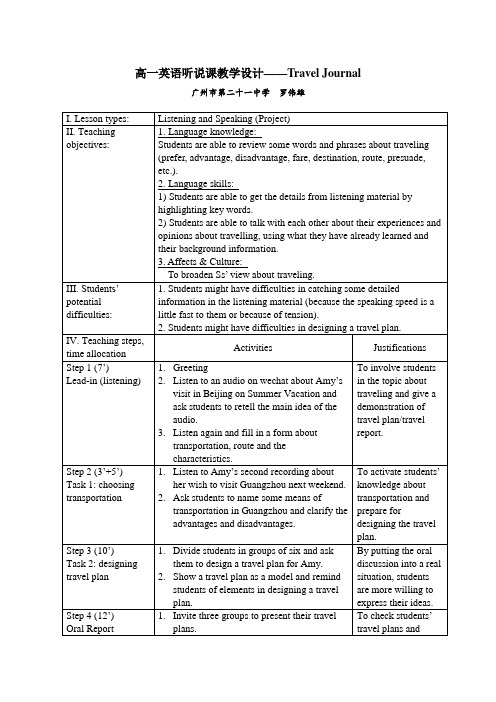
Amy: Actually, I plan to visit Guangzhou next weekend. I am wondering whether you can help me to plan a route for Guangzhou. If you could, please reply to me soon.
By putting the oral discussion into a real situation, students are more willing to express their ideas.
Step 4 (12’)
Oral Report
1.Invite three groups to present their travel plans.
3. Affects & Culture:
To broaden Ss’ viewabout traveling.
III. Students’ potential difficulties:
1. Students might have difficulties in catching some detailed information in the listening material (because the speaking speed is a little fast to them or because of tension).
2.Ask students toname somemeans oftransportationin Guangzhouand clarify the advantages and disadvantages.
To activate students’ knowledge about transportation and prepare for designing the travel plan.
英语人教版高中必修一(新课标)教案Unit 3 Listening and Speaking 教案

Unit 3 Sports and FitnessPeriod 1 Listening and Speaking教材分析开篇页选择了年轻人晨跑作为主题图,体现出一种奋进向上以及“生命在于运动”的积极意义,引入运动和健康学习这一单元。
现代奥运之父顾拜旦(Pierre de Coubertin)的名言“All sports for all people.”诠释了人人都有运动的权利。
听说板块围绕“邀请朋友参加体育运动(Invite a friend to a sports event)”,学生通过听两段介绍运动项目的对话,了解体育的趣味性,并通过听和说的形式,结合语境,学习提出邀请和答复邀请的语言功能项目。
语音板块为帮助学生复习并掌握附加疑问句中升调和降调的基本知识。
教学目标1. 能正确理解使用下列词汇:soccer,stadium,boxing,marathon,event,ski。
2. 能在听力活动中抓住内容的主旨大意。
3. 通过阅读开篇页信息,熟悉单元主题语境,预测单元内容,明确学习内容。
4. 能通过运用听力材料中所提取的体育及运动的信息,学会提出邀请和答复邀请。
教学重难点【教学重点】引导学生听取对话的主旨大意,掌握该板块出现的体育运动项目的名称词。
【教学难点】指导学生使用得体的语言邀请别人以及答复邀请。
教学过程Task 1Step 1 Warming-upLook at the opening page and discuss the following questions.(1) Do you jog often?(2) What kind of sports and exercise do you like?(3) What do you think sports and exercise can do for you?(4) Do you know some famous athletes at home and abroad?设计意图:引导学生讨论开篇页所呈现的信息,引出本单元话题,并对本课将要学习的运动与健康做好铺垫。
人教必修一Unit3_Listening_and_Talking_名师教学设计

Unit 3 Listening and Talking 名师教学设计●课时内容Voice your opinion on sportsmanship主题语境:人与社会主题群:文学、艺术与体育子主题:体育精神语篇类型:对话录音文本分析:[what]本节课为听说课,学习三个学生讨论体育精神的语篇。
第一次听了解他们的观点,第二次听圈出表达同意和不同意的交际用语,然后设置小组讨论活动,根据不同的情况发表自己的看法,旨在培养学生高尚的体育精神Why]培养学生高尚的体育精神。
[How]教学材料将英语语用目标和本单元的主题语境有机结合起来,让学生在主题语境的探究过程中提高英语语用能力,深入对主题的探究。
●课时目标1.能够听懂谈论体育精神的观点和表达同意与不同意的语用话语。
2能够根据实际情况使用恰当的语言发表自己对体育精神的看法。
●重点难点重点:听懂和理解谈论体育精神的观点和看法。
难点:根据实际情况表达同意和不同意。
●教学准备教师准备:教学录音、体育比赛事例。
学生准备:预习谈论体育精神的相关语言。
●教学过程Step I 学习理解活动一:获取与梳理1.Listen and match(SB,P41,Part 1)(1)Go through the questions with students and make sure they understand their tasks and the meanings of the three sentences.(2)Play the tape for students to listen and match the ideas.(3)Share the answers.(4)Give opinions and reasons.Ask students to work in groups and discuss who they agree with and give their reasons.2.Listen and circle(SB,P41,Part 2)Play the tape again for students to listen and circle the expressions that they hear in the conversation.AgreeingI agree. Yes,I think so.So do I. Me too.Exactly! Sure. /Certainly. /Of course.All right. You're right/correct.Good idea. I guess so.DisagreeingI’m sorry but I disagree/don’t agree.I don’t think so.That’s not right.That doesn’t make any sense!That’s not how I see it.I see what you mean,but…【设计意图】播放两次录音,第一次让学生听并且匹配Cao Jing和Max的观点,第二次让学生圈出所听到的同意和不同意的句子或短语。
Unit3+听力课教案 高中英语人教版(2019)必修第一册
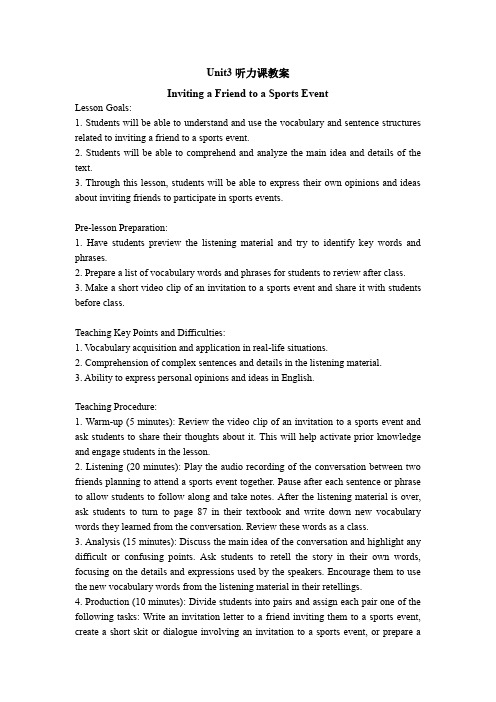
Unit3听力课教案Inviting a Friend to a Sports EventLesson Goals:1. Students will be able to understand and use the vocabulary and sentence structures related to inviting a friend to a sports event.2. Students will be able to comprehend and analyze the main idea and details of the text.3. Through this lesson, students will be able to express their own opinions and ideas about inviting friends to participate in sports events.Pre-lesson Preparation:1. Have students preview the listening material and try to identify key words and phrases.2. Prepare a list of vocabulary words and phrases for students to review after class.3. Make a short video clip of an invitation to a sports event and share it with students before class.Teaching Key Points and Difficulties:1. V ocabulary acquisition and application in real-life situations.2. Comprehension of complex sentences and details in the listening material.3. Ability to express personal opinions and ideas in English.Teaching Procedure:1. Warm-up (5 minutes): Review the video clip of an invitation to a sports event and ask students to share their thoughts about it. This will help activate prior knowledge and engage students in the lesson.2. Listening (20 minutes): Play the audio recording of the conversation between two friends planning to attend a sports event together. Pause after each sentence or phrase to allow students to follow along and take notes. After the listening material is over, ask students to turn to page 87 in their textbook and write down new vocabulary words they learned from the conversation. Review these words as a class.3. Analysis (15 minutes): Discuss the main idea of the conversation and highlight any difficult or confusing points. Ask students to retell the story in their own words, focusing on the details and expressions used by the speakers. Encourage them to use the new vocabulary words from the listening material in their retellings.4. Production (10 minutes): Divide students into pairs and assign each pair one of the following tasks: Write an invitation letter to a friend inviting them to a sports event, create a short skit or dialogue involving an invitation to a sports event, or prepare apresentation on the topic using visual aids. Allow time for students to work on their tasks individually, then have them present their ideas to the class. Encourage peer evaluation and feedback.5. Consolidation (5 minutes): Review the key points of the lesson and ask students to share one thing they learned or enjoyed about today's lesson. Provide additional practice exercises for homework, if necessary.Homework:1. Revise vocabulary words from today's lesson in their notebooks.2. Write a short paragraph introducing themselves and inviting a friend to join them in participating in a sports event next week. Use at least three new vocabulary words from today's lesson.。
Listening+and+Speaking+教案 高中英语人教版(2019)必修第一册 (1)

Unit3听力课教案Inviting a Friend to a Sports Event一、Teaching Objectives:1. Students will be able to understand and use the vocabulary and phrases related to inviting a friend to a sports event.2. Students will be able to practice their listening skills by following a conversation between two friends about an upcoming sports event.3. Students will be able to participate in a role-play activity where they can practice using the vocabulary and phrases learned in context.二、Teaching Key Points and Difficulties:1. V ocabulary and phrases related to inviting a friend to a sports event, such as "invite", "join", "participate", "watch", "support".2. Listening for key words and understanding the context of the conversation.3. Participating in role-play activities and practicing using the vocabulary and phrases in context.三、Academic Analysis:The students are at an intermediate level of English language proficiency. They have a good understanding of basic grammar and vocabulary, but may struggle with more complex conversations and activities. The topic of inviting a friend to a sports event is relevant and engaging, which will help students to improve their listening skills and expand their vocabulary.四、Teaching Process:1.Warm-up (5 minutes):Begin the lesson by asking students if they have ever invited a friend to a sports event. Encourage them to share their experiences and ask questions about the process. This will help to activate prior knowledge and create a comfortable learning environment.2.Listening Practice (10 minutes)Play a short conversation between two friends discussing an upcoming sports event. As they talk, pause the recording and ask students to write down key words or phrases they hear. After the conversation, review the key words and phrases together as a class.3.V ocabulary Practice (10 minutes)Distribute the list of key words and phrases from the listening practice section tostudents. Ask them to define each word or phrase and provide examples of how they could use it in a sentence. Review the definitions together as a class.4.Role-play Activity (15 minutes)Divide students into pairs or small groups. Give each group a scenario where one person is inviting another person to a sports event. The roles should be assigned based on the students' preferences or strengths. Encourage students to use the vocabulary and phrases they have learned in the previous exercises in their role-play activity. After each group has finished, facilitate a class discussion to review the key points and difficulties encountered during the activity.5.Consolidation (5 minutes)Review the key points and difficulties of the lesson as a class. Ask students if there were any challenges during the role-play activity or if they had any questions about the vocabulary or phrases learned. End the lesson by encouraging students to invite their friends to a sports event in the near future.。
Unit3+听力课教案 高中英语人教版(2019)必修第一册 (2)

Unit3听力课教案"Invite a Friend to a Sports Event"Teaching Objectives:1. Students will be able to understand and use the vocabulary and grammar related to inviting friends to a sports event.2. Students will be able to express their opinions and ideas about inviting friends to a sports event in English.3. Students will be able to practice their listening skills by participating in group discussions and activities.Teaching Key Points and Difficulties:1. V ocabulary related to inviting friends to a sports event, such as "invitation," "participate," "join," "compete," etc.2. Grammar related to making invitations and responding to them, such as present simple tense, imperative sentences, etc.3. Listening skills improvement through group discussions and activities.Teaching Procedure:1. Warm-up (5 minutes)- Greet students and ask them about their plans for the weekend or any upcoming events they are excited about.- Introduce the topic of inviting friends to a sports event and ask students if they have ever been invited to one.2. Presentation (10 minutes)-Introduce key vocabulary related to inviting friends to a sports event, such as "invitation," "participate," "join," "compete," etc.-Use examples and explanations to help students understand the meaning and usage of these words.- Introduce some basic grammar related to making invitations and responding to them, such as present simple tense, imperative sentences, etc.3. Practice (15 minutes)- Divide students into groups of four or five and give each group a scenario related to inviting friends to a sports event.- Ask students in each group to discuss the scenario and come up with different ways of inviting their friends and expressing their opinions about it.- Encourage students to use the vocabulary and grammar learned in class duringtheir discussions.-After the discussion, ask each group to share their ideas with the class and provide feedback on each other's suggestions.4. Consolidation (10 minutes)- Play a short audio clip of two friends discussing an invitation to a sports event in English, with questions and answers at the end of the clip.-Ask students to listen carefully and answer the questions based on what they heard.- Discuss the answers together as a class and provide feedback on pronunciation, intonation, and comprehension.5. Homework (5 minutes)- Ask students to write a short essay about inviting friends to a sports event using the vocabulary and grammar learned in class.-Encourage students to include personal experiences or stories related to this topic.-Review the essay next class session and provide feedback on content, organization, and language use.After Class Activity:Ask students to exchange their essays with their partners and give each other feedback on their writing skills, vocabulary usage, and grammar accuracy. This activity can help students practice their listening skills while also improving their writing abilities.。
- 1、下载文档前请自行甄别文档内容的完整性,平台不提供额外的编辑、内容补充、找答案等附加服务。
- 2、"仅部分预览"的文档,不可在线预览部分如存在完整性等问题,可反馈申请退款(可完整预览的文档不适用该条件!)。
- 3、如文档侵犯您的权益,请联系客服反馈,我们会尽快为您处理(人工客服工作时间:9:00-18:30)。
听说课教学设计Invite a Friend to a Sports Event主题语境:人与社会——体育运动、体育赛事语篇类型:对话教材:人教版(2019版)课题: Invite a Friend to a Sports Event (Listening and Speaking) 授课时长:一课时(每课时40分钟)内容分析本单元以运动与健康为主题,本课是Listening and Speaking板块,学生学习关于体育运动、体育赛事的词汇和背景知识,初步感知附加疑问句的含义和语调,为后续板块中开展说、读、看、写活动以及语法学习作铺垫。
本板块的活动主题是“邀请朋友参加体育运动”,这和学生的日常生活密切相关。
学生不仅喜欢参加体育运动,而且对观看比赛非常感兴趣。
教材中呈现了足球、羽毛球、拳击、马拉松、电子竞技、“慈善跑”、滑雪、田径、器械健身等运动项目的场景,这些场景既包含了经典运动项目,也包含新兴运动项目,并且兼顾了室内和室外、南方和北方的运动项目。
本活动的主题意义是体现体育的趣味性,以及体育与现代科技的结合,体育与慈善事业的结合。
活动目的是让学生结合语境,通过听和说的形式,学习提出邀请和答复邀请的语言功能项目。
教材包括三段对话文本。
第一段是听力文本,Shen Qi邀请Amy去观看电子竞技比赛(其中涉及对电子竞技比赛的介绍),但Amy因为有约在身而婉拒了。
Shen Qi发出邀请时使用的语言包括“Would you like to come along?”和“Why don’t you join us…?”。
Amy答复邀请时使用的语言包括“Really? I’d love to!” “O h, sorry.” “I can’t.” “I have to…”等。
第二段是听力文本,Adam邀请Julie观看“B lue Paint” run, Julie欣然接受。
Adam 使用“Would do like to go?”向Julie发出邀请。
Julie使用“T hat sounds like a great idea!”答复邀请。
第三段对话是器械健身房内陌生人之间的small talk,谈及健身频率、健身感受、运动与健康。
三段对话都使用了附加疑问句,为本单元后面的语法学习作铺垫。
学情分析本班学生属于珠海市的优秀生源,整体外向、思维活跃,学习态度认真,充满学习热情。
大部分学生英语基础较好,在听力理解时有一定的获取信息的能力,但往往因为侧重听取个别词汇而忽略听力材料的主旨大意,听力策略有待加强。
学生乐于并善于用英语进行表达,但是在语音语调方面还有所欠缺。
在相关知识储备方面,作为“零五后”的学生不仅观看和认识很多经典体育运动和赛事,也在体育课上得到学习和体验,并普遍接触或听闻电子竞技和“彩色跑”。
另外,由于本校还承办内地新疆高中班,本地生通过与新疆生的日常交流,增加了对少数民族传统体育运动的认识。
然而,学生对体育运动和体育赛事相关词汇方面的积累不多,曾经接触过附加疑问句但印象不深刻,不能熟练地运用该结构。
在本课学习结束时,学生能够:1. 通过观看主题图和理解名言,熟悉单元的主题语境,明确单元的主要学习任务。
2. 通过头脑风暴和听取信息,了解世界各地的特色体育项目、著名运动员和大型体育赛事。
3. 在听对话时,通过注意重读词汇,获取材料主旨大意。
4. 通过听和说的形式,学会谈论自己身边将要进行的体育赛事或活动,邀请朋友参加或答复邀请。
5. 掌握附加疑问句随语境和提问者的真实意图使用不同语调的基本知识,在口语中正确使用语调表达情感,进行交流。
教学重点听取对话的主旨大意,掌握本板块出现的体育运动和体育赛事的相关词汇,认识体育运动的多样性、趣味性以及体育与健康的关系,掌握附加疑问句的语调使用。
教学难点谈论自己身边的体育运动或体育赛事,使用得体的语言邀请别人以及答复邀请。
教学资源教材、多媒体课件、黑板和粉笔(Note: IW=Individual Work; GW=Group Work; CW=Class Work; T=Teacher; Ss=Students) Step 1: Discuss the Opening Page. (2 minutes, IW, CW)Ss read the Opening Page, understand the goals of the unit and discuss the following questions.Q1: What is your first impression of the picture? What elements of the picture give you such an impression?Q2: Why is doing sports good for us?Q3: How do you understand the quote “All sports for all people”?Step 2: Brainstorm. (4 minutes, CW)1. Some posters and pictures are presented for the whole class to recall/learn the names of the events.2. 4 Ss are invited to answer questions in complete sentences.Q: What sport do you want to try? What sports events do you like to watch? You want to invite a friend to go along with you, don’t you (falling tone)?3. Ss look at another picture showing a scene of e-sports.Q: What are they doing? Is it a kind of sports event? What do you know about it?Step 3: Listen to Conversation 1. (2 minutes, IW)Q: What is Shen Qi’s main purpose for talking to Amy? (A/B/C) What is the reason for your decision?Step 4: Listen to Conversation 1 again and circle the words stressed.(3 minutes, IW, CW)Q1: Which words are stressed? Do you know how to read these sentences?Q2: Why are those words stressed?Q3: Do you see how to stress words?Step 5: Listen to Conversation 2. (8 minutes, IW, GW, CW)1. Listen to the conversation, finish the exercise of Activity 4 on P37, and check the answers with your partners.2. Listen to the conversation again and check the answers with the whole class. One student is invited to do the math to explain the answer to Q4.3. Fill in a table carrying some details of the event (if there’s any), like the name of the event, the venue, the time, participants, activities and the goal.Step 6: Have a discussion. (6 minutes, GW, CW)Ss discuss at least one of the following questions in groups and present their ideas to the whole class.Q1: E-sports events have been admitted by the Asian Games but not by the Olympics.What’s your opinion on this? Do you think it easy to balance e-sports and studies?Q2: If invited, you won’t join in the “Blue Paint” run, will you (rising tone)? Why or why not?Step 7: Summarize expressions about invitation and response. (3 minutes, IW, CW)Ss explore the texts of Conversation 1 and 2, find out the expressions about invitation and response.According to what is mentioned in th e texts and Ss’s experience, Ss and T summarize some related expressions such as:Step 8: Make a conversation. (8 minutes, GW, CW)T: What event or activity would you like to invite your friend to? Make a conversation with your partner.Tip 1: Use the information on P37, or create a sports event on your own (using theprevious table to sort out the details).Tip 2: Use the expressions about invitation and response.Tip 3: Stress some key information and your feelings when speaking.Step 9: Focus on tag questions. (3 minutes, CW)1. T repeats 2 tag questions used in previous steps and presents each of them in 2 different ways.Q1: You want to invite a friend to go along with you, don’t you (falling tone)?Q2: You want to invite a friend to go along with you, don’t you (rising tone)? Why or why not?Q3: If invited, you won’t join in the “Blue Paint” run, will you (falling tone)?Q4: If invited, you won’t join in the “Blue Paint” run, will you (rising tone)? Why or why not?2. Ss are asked to pay attention to the intonation, compare Q1 with Q2, and compare Q3 with Q4.3. Ss conclude the relationship between the intonation and the meaning ofa tag question.If you know the answer and just emphasize what you are saying, you use falling tone for a tag question.If you really want an answer, you use rising tone for a tag question.Step 10: Make a summary individually. (1 minute, IW)Ss are asked to make a summary individually by thinking over the following questions.Q1: What sports events have you learnt in this lesson?Q2: What listening or speaking strategies have you learnt in this lesson?Q3: Can you read the tag questions with correct intonation?作业设计1. Supposing that you happen to read a poster promoting an upcoming sports event that is your favorite, write an invitation to Michael, your friend from America, including:(1) some details about the sports event you are interested in;(2) the reason for your interest in the event;(3) a poster designed by yourself for the sports event.2. Study tag questions on P108 of the textbook. Practice the conversation on P37 by imitating the audio recording.3. Do some research on your favorite athlete(s).板书设计板书设计(注释版)课文原文(指导教师:广东省教育研究院罗永华;珠海市教育研究中心李昂;珠海市实验中学陆金范)。
